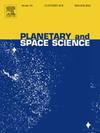Key structural characteristics of porous layers in diffusion modelling: A study on polydispersity, shape, and hierarchy
IF 1.7
4区 物理与天体物理
Q3 ASTRONOMY & ASTROPHYSICS
引用次数: 0
Abstract
In this study, we explored various open-source models for generating porous media. These models enabled us to examine different types of porous beds, including layers of polydisperse spheres with various size distributions, layers of porous aggregates – either fragments of parent porous layers or those formed during the agglomeration of polydisperse spheres – and layers of non-spherical particles with both regular and random shapes. Through extensive simulations, we derived estimates for the averaged structural characteristics of the model layers. These estimates will be utilized in macroscopic models to study heat diffusion and the sublimation of products in the near-surface layer of a cometary nucleus. Our findings revealed significant differences between the obtained estimates and those previously made for layers of monodisperse spheres, underscoring the importance of this research. We also compared numerical results with theoretical formulas for layers of monodisperse spheres.

扩散模型中多孔层的关键结构特征:多分散性、形状和层次的研究
在这项研究中,我们探索了各种开源模型来生成多孔介质。这些模型使我们能够研究不同类型的多孔层,包括具有不同尺寸分布的多分散球体层,多孔聚集体层-要么是母体多孔层的碎片,要么是在多分散球体聚集过程中形成的-以及具有规则和随机形状的非球形颗粒层。通过广泛的模拟,我们对模式层的平均结构特征进行了估计。这些估计将在宏观模型中用于研究彗星核近表层的热扩散和产物升华。我们的发现揭示了所获得的估计值与先前对单分散球体层所做的估计值之间的显着差异,强调了本研究的重要性。我们还将单分散球层的数值计算结果与理论计算公式进行了比较。
本文章由计算机程序翻译,如有差异,请以英文原文为准。
求助全文
约1分钟内获得全文
求助全文
来源期刊

Planetary and Space Science
地学天文-天文与天体物理
CiteScore
5.40
自引率
4.20%
发文量
126
审稿时长
15 weeks
期刊介绍:
Planetary and Space Science publishes original articles as well as short communications (letters). Ground-based and space-borne instrumentation and laboratory simulation of solar system processes are included. The following fields of planetary and solar system research are covered:
• Celestial mechanics, including dynamical evolution of the solar system, gravitational captures and resonances, relativistic effects, tracking and dynamics
• Cosmochemistry and origin, including all aspects of the formation and initial physical and chemical evolution of the solar system
• Terrestrial planets and satellites, including the physics of the interiors, geology and morphology of the surfaces, tectonics, mineralogy and dating
• Outer planets and satellites, including formation and evolution, remote sensing at all wavelengths and in situ measurements
• Planetary atmospheres, including formation and evolution, circulation and meteorology, boundary layers, remote sensing and laboratory simulation
• Planetary magnetospheres and ionospheres, including origin of magnetic fields, magnetospheric plasma and radiation belts, and their interaction with the sun, the solar wind and satellites
• Small bodies, dust and rings, including asteroids, comets and zodiacal light and their interaction with the solar radiation and the solar wind
• Exobiology, including origin of life, detection of planetary ecosystems and pre-biological phenomena in the solar system and laboratory simulations
• Extrasolar systems, including the detection and/or the detectability of exoplanets and planetary systems, their formation and evolution, the physical and chemical properties of the exoplanets
• History of planetary and space research
 求助内容:
求助内容: 应助结果提醒方式:
应助结果提醒方式:


